Frost Protection - UTL Repository
Frost Protection - UTL Repository
Frost Protection - UTL Repository
You also want an ePaper? Increase the reach of your titles
YUMPU automatically turns print PDFs into web optimized ePapers that Google loves.
ACTIVE PROTECTION METHODS<br />
temperature in a citrus grove irrigated with water at 23 °C. In this method, water<br />
is applied to a field and heat from the water is released to the air as it cools. The<br />
temperature of the water is important because warmer water will release more<br />
heat as it cools. <strong>Protection</strong> is best on the first night after flooding and it becomes<br />
less efficient as the soil becomes saturated. Water can be applied until there is<br />
partial or total submersion of tolerant plants; however, fungal disease and root<br />
asphyxiation are sometimes a problem. Generally, the method works best for<br />
low-growing tree and vine crops during radiation frosts. In an experiment on<br />
tomatoes, unprotected plants showed complete damage (Rosenberg, Blad and<br />
Verma, 1983). Using over-plant sprinkler irrigation gave better protection than<br />
with furrow irrigation, but the damage was minor for both methods.<br />
Flooding<br />
Direct flooding is commonly used for frost protection in many countries. For<br />
example, in Portugal and Spain, growers apply a continuous flow of water to a<br />
field that partially or totally submerges the plants (Cunha, 1952; Díaz-Queralto,<br />
1971). In Portugal, it has mostly been used to protect pastures of ryegrass and<br />
Castilian grass (Cunha, 1952), but it has been successfully used on a variety of<br />
crops in California and other locations in the USA. Because of the relatively low<br />
cost of flood irrigation, the economic benefits resulting from its use for frost<br />
protection are high. The volume of water to apply depends on the severity of the<br />
frost and the water temperature. Businger (1965) indicates that 4 °C of<br />
protection can be achieved with this method if irrigation is done prior to a frost<br />
event; whereas Georg (1979) reports that direct flooding has given temperature<br />
rises near 3 °C in a pimento pepper crop on a frost night.<br />
Liquid water is denser when the temperature is about 4 °C than at lower<br />
temperatures, so water at temperatures less than 4 °C will rise to the surface and<br />
hence water freezes from the top down. Once the ice forms on the surface, an air<br />
space develops between the liquid water below and the ice above that insulates<br />
against the transfer of heat from below. Then the ice-covered surface temperature<br />
can fall below 0 °C and lead to colder surface and air temperatures.<br />
Furrow irrigation<br />
Furrow irrigation is commonly used for frost protection and the basic concepts are<br />
similar to flood irrigation. Both free convection of air warmed by the water and<br />
upward radiation are enhanced by flow of warmer water down the furrows. The<br />
main direction of the radiation and sensible heat flux is vertical, so the best results<br />
are achieved when the furrows are directly under the plant parts being protected.<br />
181


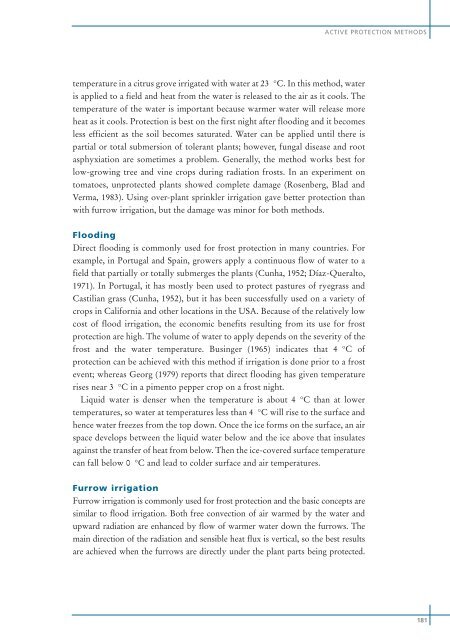
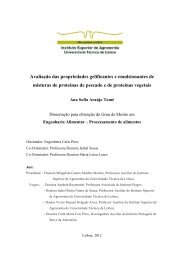
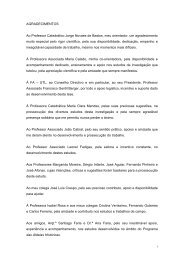
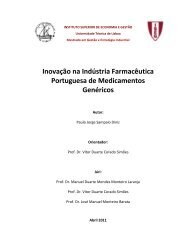
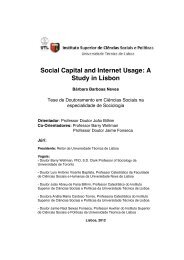
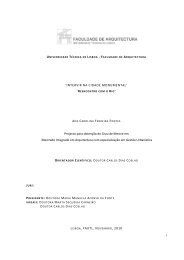
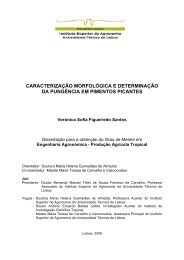

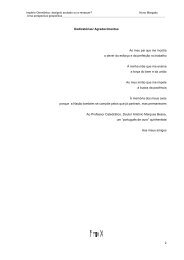
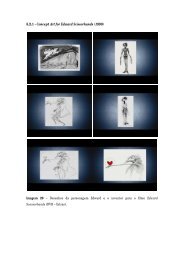
![Tese - Es..[1].pdf - UTL Repository - Universidade Técnica de Lisboa](https://img.yumpu.com/25707135/1/184x260/tese-es1pdf-utl-repository-universidade-taccnica-de-lisboa.jpg?quality=85)


